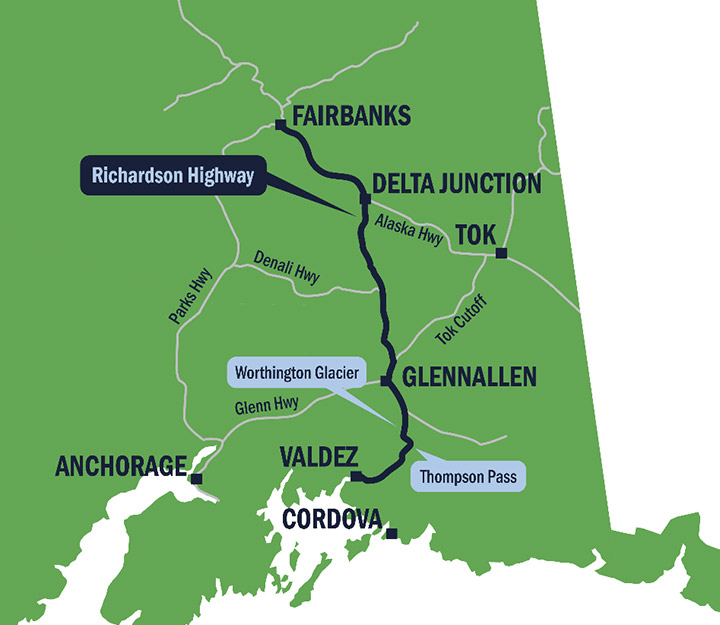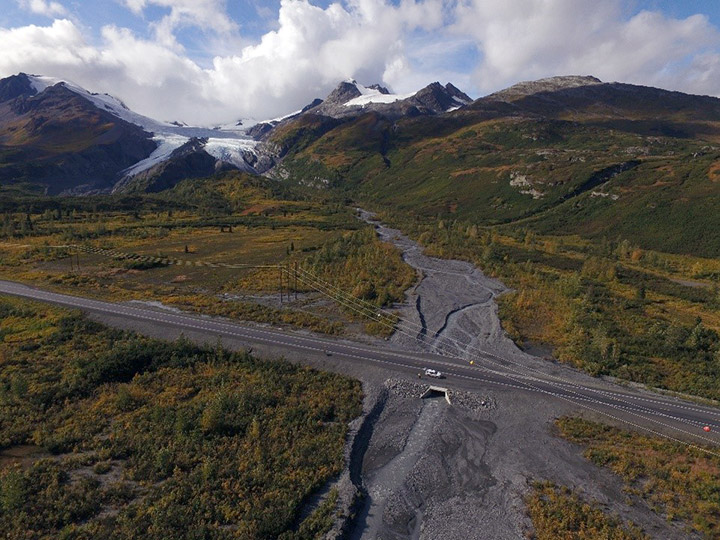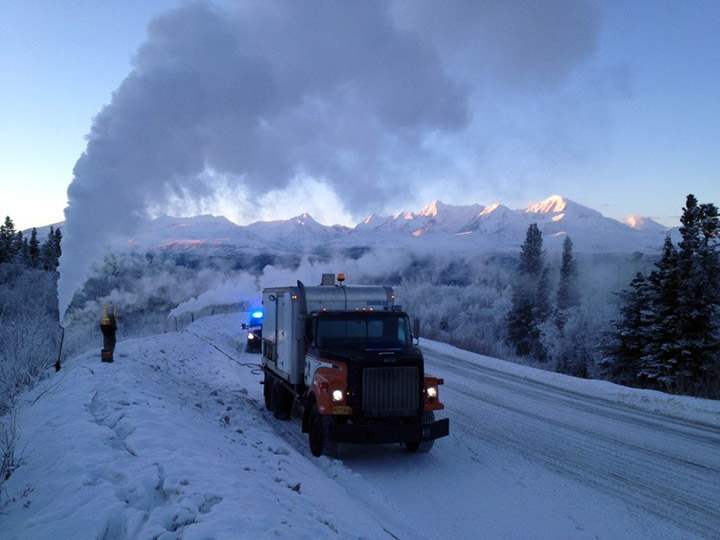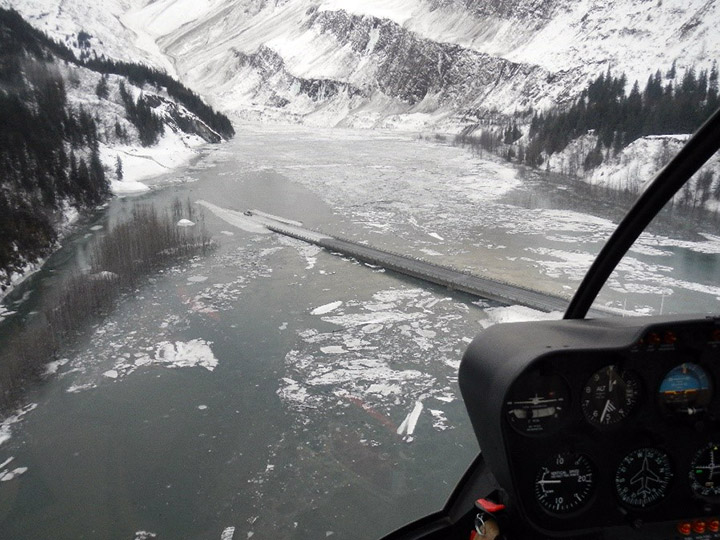Richardson Highway
Valdez to Fairbanks
The Richardson Highway is one of two main arteries that runs from the Southcentral coast into Interior Alaska. It intersects with seven other major highways in the state, including the Alaska Highway (the state’s road link to the rest of the continent), the Steese Highway (the road gateway to the northern half of the state), and the Parks Highway (Alaska’s other major road into the Interior). This highway was Alaska’s first major long-distance road and it remains an essential piece of the state’s minimal road infrastructure.

Highway overview
The Richardson Highway runs for 366 miles from Valdez, a coastal community nestled into the Chugach Mountains on the Prince William Sound, to Fairbanks, the hub city of Interior Alaska. The highway starts off out of Valdez through Thompson Pass, one of the most notoriously snowy mountain passes in the state, then runs along the Copper River and some of the best salmon fishing in the world, through the Alaska Range, to the boreal forests along the Tanana River, and into Fairbanks from the southeast.
Drivers can expect beautiful views of mountains and glaciers along this route, much of which has been designated as a Scenic Byway. It is paved for its entire length and is mostly a two-lane highway until just south of Fairbanks, where it functions as a commuter route for traffic between Fairbanks and the city of North Pole. Although services are more sparse along this route than most of the major highways in the Lower 48, drivers will find plenty of food and gas along the way.

Richardson Highway box culvert at Worthington Glacier. Photo by Travis Donovan, DOT&PF
How is the highway maintained?
Alaska DOT&PF operates eight maintenance stations within three maintenance districts along the Richardson Highway corridor, one of which (Thompson Pass) is only open in the winter. Current road condition information for this route and others around the state can be found through our 511 Traveler Information system. For information about maintenance station schedules and staffing, visit the Northern Region Maintenance & Operations webpage.

Equipment operator Eric Child thaws a drainage structure on the Richardson Highway near Delta Junction. Photo by Dave McCombs, DOT&PF staff
The entire length of the Richardson Highway is maintained year-round. In the summer months, crews focus on preventative maintenance and repair work like patching asphalt, sealing cracks in the asphalt, repairing culverts and guardrail, refreshing paint striping, and repairing shoulders. In the winter months, crews focus on plowing snow, responding to storms, and clearing avalanches from the road.
While driving this route in the summer is typically smooth sailing, except for some rough pavement in sections, the long winter can bring serious weather to any stretch along the Richardson Highway’s 366 miles. Heavy snow and high winds can shut the highway down for days at a time. Avalanches hit the road several times each year. The Thompson Pass station even has an avalanche expert on staff who helps mitigate the risk for travelers.
In January 2014, one of the biggest winter events in Richardson Highway history shut the highway down for 12 days, cutting off the community of Valdez to all road access. The event was dubbed “damalanche” because a series of avalanches that blocked the highway also dammed the Lowe River, causing a lake to form over the road that was 30 feet deep and about a half-mile long. You can read more about damalanche here.

Snowslide Gulch at mile 16 on the Richardson Highway, north side of damalanche on January 28, 2014. Photo by Robert Dunning, Alaska DOT&PF
Richardson Highway History
The Richardson Highway was Alaska’s first long-distance road into the Interior. It started as a trail to access gold camps in Eagle along the Yukon River in the late 1800s. Before long the gold rush in Fairbanks began and the trail was upgraded to a wagon road. In the 1920s, it was upgraded again to suit automobile standards and began to grow in importance as a freight route into the Interior.
World War II turned the remote community of Fairbanks into an important location for military operations, which spurred further development of the highway into an all-season route. During the war years, the Richardson Highway saw major upgrades, including new bridges across all the rivers where ferries had operated before. Despite being built for all seasons, the extreme snowfall in Thompson pass just outside Valdez kept the road closed in the winter until regular winter maintenance began in the mid-1950s.
The following excerpt about the Richardson Highway comes from the booklet Historic Roads of Alaska: Driving the History of the Last Frontier published in 2017 by Alaska DOT&PF and other state agencies with funding from the Federal Highway Administration. You can download a PDF copy of the booklet here to read the full chapter on the Richardson Highway and learn about the history of other Alaska roads.
From chapter 2 of Historic Roads of Alaska: Driving the History of the Last Frontier:
It was the discovery of gold near Fairbanks in 1902, and the subsequent gold rush that created the city in the years afterward, that determined the course of the Richardson Highway. Stampeders and suppliers began heading to Fairbanks rather than Eagle, and the route of the trail changed in response to this growing Fairbanks traffic. Under Major Wilds P. Richardson, the [Alaska Road Commission or ARC] upgraded the Valdez-Fairbanks Trail to a wagon road, so that by 1910 it was possible for vehicles to make the trip. The ARC put a log and gravel corduroy surface over wetter stretches, widened some parts of the road, including through Thompson Pass, and built bridges or established ferries over streams, often in conjunction with local residents.
Within a few years, pioneering motorists began to tackle the road in their cars, including Robert Sheldon, a Fairbanks resident who claimed to have built the first automobile in Alaska when he lived in Skagway in 1905. In July 1913, Sheldon and three passengers set out from Fairbanks in his Ford Model T with a banner proclaiming “Valdez or Bust” hanging off its side. At Big Delta, they had to build a raft out of poling boats to ferry their car across the Tanana River; other streams they just drove through. The trip took a total of 59 hours to reach Valdez, with a side trip to Chitina along the way. A few days later, an Army truck made the first trip from Valdez to Fairbanks, averaging 8-9 miles per hour, with a top speed of 18 miles per hour. These first trips showed that the Richardson Highway could be a viable route for motorized transport if it was upgraded to a slightly higher standard.
Savvy entrepreneurs, including Sheldon, took advantage of the access that the Richardson Highway provided and began operating motor stage lines between Fairbanks and Valdez. These cars offered passengers a relatively comfortable means of travel, sometimes in large luxury vehicles like Sheldon’s Pope Toledo. The trip still usually took several days and the passengers would arrive covered in dust and dirt, sometimes as a result of having to help pull the car out of thick mud. As one traveler said, “When the car dropped out of sight and was submerged in mud, I decided that what we needed most was a periscope and a compass to steer by while traveling beneath the surface of the Sea of Muck.” The typical trip cost $100 (approximately $2,500 in 2017 dollars) for a passenger and up to forty pounds of baggage.

